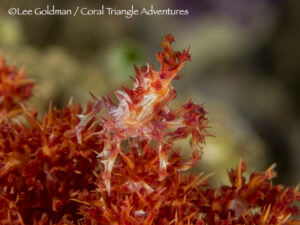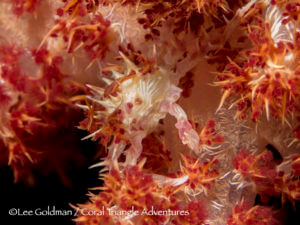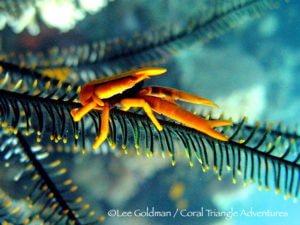
Secretive commensal crustaceans are the norm in Kimbe Bay, Papua New Guinea
One of the most impressive things about snorkeling in Kimbe Bay was the relatively easy access to some of the smaller commensal critters that often elude even the sharpest eyes. While nudibranchs, sea horses, and juvenile fishes are hard to spot, they are nothing compared to the masters of camouflage like crinoid (feather star) shrimp, soft coral crabs, squat lobsters, and gorgonian spider crabs. The common theme among these critters is that their chosen habitats revolve completely around the host organism and, as such, they have evolved a physical appearance that mimics the host’s appearance. It is the evolution towards a perfect form of camouflage. The obvious advantage is that they remain well hidden, and thus protected from potential predators.
While these critters are worth the time invested in looking for them, it is hard to realize the payout when 30 minutes into the endeavor, peering into yet another nest of feathery arms of a crinoid comes up empty once again. As we found out, it seems that gorgonian sea fans, crinoid feather stars and soft corals in Kimbe Bay, Papua New Guinea, have an over abundance of these amazing crustaceans. At times, finding one was just a matter of deciding to look for one. See a soft coral, there was probably a soft coral crab living upon it. There’s a gorgonian sea fan, and a gorgonian spider crab was sure to be hiding out on it. Few, if any, other places in the Coral Triangle can boast such a claim!
Crinoid shrimp and squat lobsters live exclusively on crinoid feather stars, gorgonian spider crabs prefer to dwell on gorgonian sea fans, and soft coral crabs are found only on the colorful dendronephthya soft corals. Sea fans, crinoid feather stars and dendronphthya soft corals are all filter feeders, settling in areas where water movement brings them their preferred food item, plankton. The tiny commensals that live upon them scavenge food from debris that collects on the host or may even feed on the host itself, but do not appear to impact their host by doing so. It is thought that even though, for example, squat lobsters may feed upon their host, they also protect their host from potential predators by discouraging a predator by pinching at them with their claws.
The attention to detail among these commensal crustaceans is remarkable. Soft coral crabs that live on dendronphtheya soft corals not only take the physical appearance by appearing white with small reddish bumps on their carapace that resemble the red polyps of the soft coral, they even have whitish streaks on their shell that mimic the white spicules embedded in the tissue of their host soft coral.
The allure of these critters is easy to understand. And while we admire their strategy and success, it is also what makes them frustratingly hard to find…except in Kimbe Bay, Papua New Guinea.




